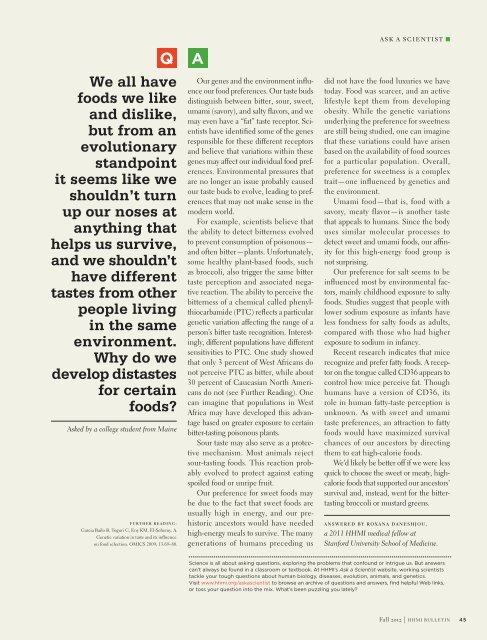Download PDF - Howard Hughes Medical Institute
Download PDF - Howard Hughes Medical Institute
Download PDF - Howard Hughes Medical Institute
Create successful ePaper yourself
Turn your PDF publications into a flip-book with our unique Google optimized e-Paper software.
q<br />
We all have<br />
foods we like<br />
and dislike,<br />
but from an<br />
evolutionary<br />
standpoint<br />
it seems like we<br />
shouldn’t turn<br />
up our noses at<br />
anything that<br />
helps us survive,<br />
and we shouldn’t<br />
have different<br />
tastes from other<br />
people living<br />
in the same<br />
environ ment.<br />
Why do we<br />
develop distastes<br />
for certain<br />
foods?<br />
Asked by a college student from Maine<br />
FURTHER reading:<br />
Garcia Bailo B, Toguri C, Eny KM, El-Sohemy, A.<br />
Genetic variation in taste and its influence<br />
on food selection. OMICS 2009; 13:69–80.<br />
A<br />
Our genes and the environment influence<br />
our food preferences. Our taste buds<br />
distinguish between bitter, sour, sweet,<br />
umami (savory), and salty flavors, and we<br />
may even have a “fat” taste receptor. Scientists<br />
have identified some of the genes<br />
responsible for these different receptors<br />
and believe that variations within these<br />
genes may affect our individual food preferences.<br />
Environmental pressures that<br />
are no longer an issue probably caused<br />
our taste buds to evolve, leading to preferences<br />
that may not make sense in the<br />
modern world.<br />
For example, scientists believe that<br />
the ability to detect bitterness evolved<br />
to prevent consumption of poisonous—<br />
and often bitter—plants. Unfortunately,<br />
some healthy plant-based foods, such<br />
as broccoli, also trigger the same bitter<br />
taste perception and associated negative<br />
reaction. The ability to perceive the<br />
bitterness of a chemical called phenylthiocarbamide<br />
(PTC) reflects a particular<br />
genetic variation affecting the range of a<br />
person’s bitter taste recognition. Interestingly,<br />
different populations have different<br />
sensitivities to PTC. One study showed<br />
that only 3 percent of West Africans do<br />
not perceive PTC as bitter, while about<br />
30 percent of Caucasian North Americans<br />
do not (see Further Reading). One<br />
can imagine that populations in West<br />
Africa may have developed this advantage<br />
based on greater exposure to certain<br />
bitter-tasting poisonous plants.<br />
Sour taste may also serve as a protective<br />
mechanism. Most animals reject<br />
sour-tasting foods. This reaction probably<br />
evolved to protect against eating<br />
spoiled food or unripe fruit.<br />
Our preference for sweet foods may<br />
be due to the fact that sweet foods are<br />
usually high in energy, and our prehistoric<br />
ancestors would have needed<br />
high-energy meals to survive. The many<br />
generations of humans preceding us<br />
ask a scientist<br />
did not have the food luxuries we have<br />
today. Food was scarcer, and an active<br />
lifestyle kept them from developing<br />
obesity. While the genetic variations<br />
underlying the preference for sweetness<br />
are still being studied, one can imagine<br />
that these variations could have arisen<br />
based on the availability of food sources<br />
for a particular population. Overall,<br />
pref erence for sweetness is a complex<br />
trait—one influenced by genetics and<br />
the environment.<br />
Umami food—that is, food with a<br />
savory, meaty flavor—is another taste<br />
that appeals to humans. Since the body<br />
uses similar molecular processes to<br />
detect sweet and umami foods, our affinity<br />
for this high-energy food group is<br />
not surprising.<br />
Our preference for salt seems to be<br />
influenced most by environmental factors,<br />
mainly childhood exposure to salty<br />
foods. Studies suggest that people with<br />
lower sodium exposure as infants have<br />
less fondness for salty foods as adults,<br />
compared with those who had higher<br />
exposure to sodium in infancy.<br />
Recent research indicates that mice<br />
recognize and prefer fatty foods. A receptor<br />
on the tongue called CD36 appears to<br />
control how mice perceive fat. Though<br />
humans have a version of CD36, its<br />
role in human fatty-taste perception is<br />
unknown. As with sweet and umami<br />
taste preferences, an attraction to fatty<br />
foods would have maximized survival<br />
chances of our ancestors by directing<br />
them to eat high-calorie foods.<br />
We’d likely be better off if we were less<br />
quick to choose the sweet or meaty, highcalorie<br />
foods that supported our ancestors’<br />
survival and, instead, went for the bittertasting<br />
broccoli or mustard greens.<br />
Answered by Roxana Daneshjou,<br />
a 2011 HHMI medical fellow at<br />
Stanford University School of Medicine.<br />
Science is all about asking questions, exploring the problems that confound or intrigue us. But answers<br />
can’t always be found in a classroom or textbook. At HHMI’s Ask a Scientist website, working scientists<br />
tackle your tough questions about human biology, diseases, evolution, animals, and genetics.<br />
Visit www.hhmi.org/askascientist to browse an archive of questions and answers, find helpful Web links,<br />
or toss your question into the mix. What’s been puzzling you lately?<br />
Fall 2o12 | h h m i b u l l e t i n<br />
45
















